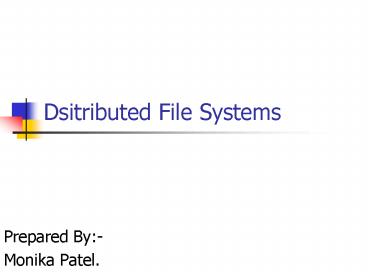Dsitributed File Systems - PowerPoint PPT Presentation
1 / 14
Title:
Dsitributed File Systems
Description:
Dsitributed File Systems Prepared By:-Monika Patel. Outline:- What is Distributed File System? (DFS) Characteristics of DFS Transparency Concurrent File Updates File ... – PowerPoint PPT presentation
Number of Views:70
Avg rating:3.0/5.0
Title: Dsitributed File Systems
1
Dsitributed File Systems
- Prepared By-
- Monika Patel.
2
Outline-
- What is Distributed File System? (DFS)
- Characteristics of DFS
- Transparency
- Concurrent File Updates
- File Replication
- Fault Tolerance
- Security
- IBMs DCE Distributed File Service
-
3
Why we need File System?
- Persistent Data objects need to be stored on a
long term basis for later use. They must be named
and saved on a non volatile data Storage device
such as magnetic disk. - This data objects are known as a file.
- In any operating system File system is a major
component and its responsible for the
organization, storage, retrieval, naming, sharing
and protection of files.
4
- File systems also take responsibility for the
control of access to files, restricting access to
files according to users authorizations and the
type of access requested - The term "metadata is often used to refer to all
of the extra information stored by a file system
that is needed for the management of files - The file system is responsible for applying
access control for files
5
Distributed File System
- Its an implementation of a file system that
consist of physically distributed storage sites
but provides a traditional centralized file
system view for the user.
6
DFS Characteristics-
- Transparency
- Access Transparency-A user can login in at any
host in the system with uniform login procedure,
independent of the host. - In other word program designed to work on
a local file can work on a remote file without
modification - Location Independency-files or groups of files
can be - relocated without changing their actual path
(or file) names.
7
Transparency cont.(DFS introduction
,lasnost.itcarlow.ie/barryp/slides/DFSintro.pdf )
- Mobility transparency- A file may be moved,
either by systems administrators or
automatically. - Performance transparency- programs should
continue to perform satisfactorily, even under
heavy load. - Scaling transparency- file systems can be
expanded by incremental growth to deal with a
wide range of loads and network sizes.
8
- Concurrent File Updates-Changes to a file by one
client should not interfere with the operation of
other clients simultaneously accessing or
changing the same file. - Transaction based application requires that the
application appears to access the files in
isolation. - For any DFS its desirable to support concurrency
control at transaction level.
9
- File Replication-Several copies of a file's
contents at different locations enable multiple
servers to share the load of providing the
service - DFS with replication transparency performs atomic
updates on the replicas and client are not aware
that there is more then one copy exist.
10
- Fault tolerance-It is essential that the file
service continue to operate in the face of client
and server failures. - Another important design goal is statelessness
the File server can be restarted and the service
restored after a failure without any need to
recover "previous state.
11
- Security- To access control lists, there is a
need to authenticate client requests so that
access control at the server is based on correct
user identities. - There is also a need to protect the contents of
request and reply messages with digital
signatures and encryption of secret data.
12
IBMs DCE Distributed File Service
characteristics (By Agustin Mena III and Carl
Burnett)
- Client Caching-Client caching allows the
majority of file read/write operations to occur
locally on the client, thereby avoiding network
traffic and server resource utilization. - Maintaining cache Consistency-Cache consistency
is maintained internally in DFS through the use
of tokens. Tokens are guarantees from the file
server that a client can perform certain
operations on files residing in the client cache.
- Security-DFS is tightly integrated with the DCE
Security Service. DCE Access Control Lists (ACLs)
protect files in DFS. Communication between DFS
clients and servers takes place using an
authenticated RPC mechanism
13
Refrences-
- 1Performance Characteristics of the DCE
Distributed File Service By Agustin Mena III and
Carl Burnett. - http//www.306.ibm.com/software/network/dce/librar
y/whitepapers/dfsperfhtmlHeader_3. - 2 http//glasnost.itcarlow.ie/barryp/slides/DFS
intro.pdf - 3 Distributed operating systems Algorithms,By
Randy chow,Theodore johnson. - 4 Distributed File Systems Pierre Boulet
Masters Informatique TIIR et IAGL September
28,2006.
14
- Thank You.































